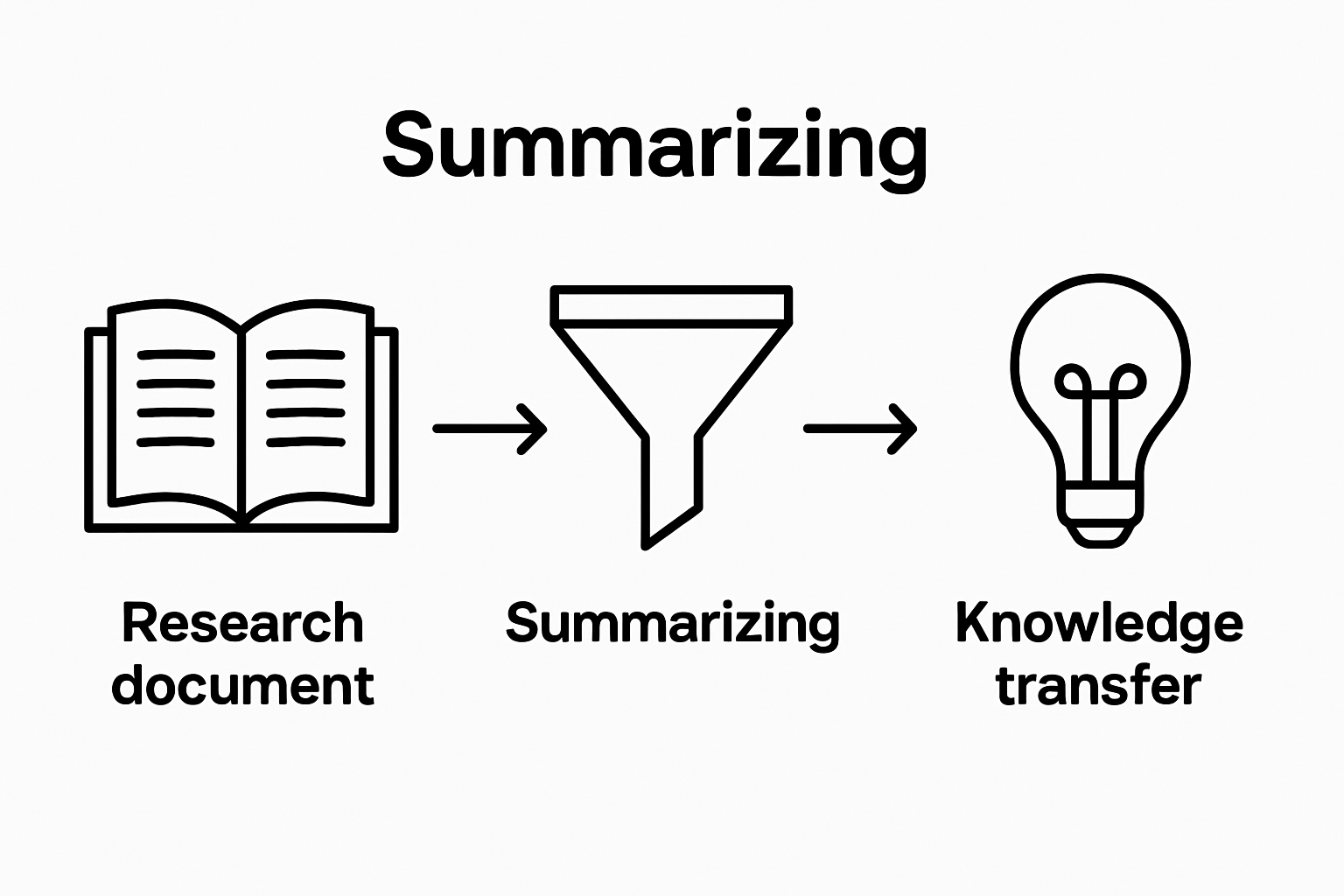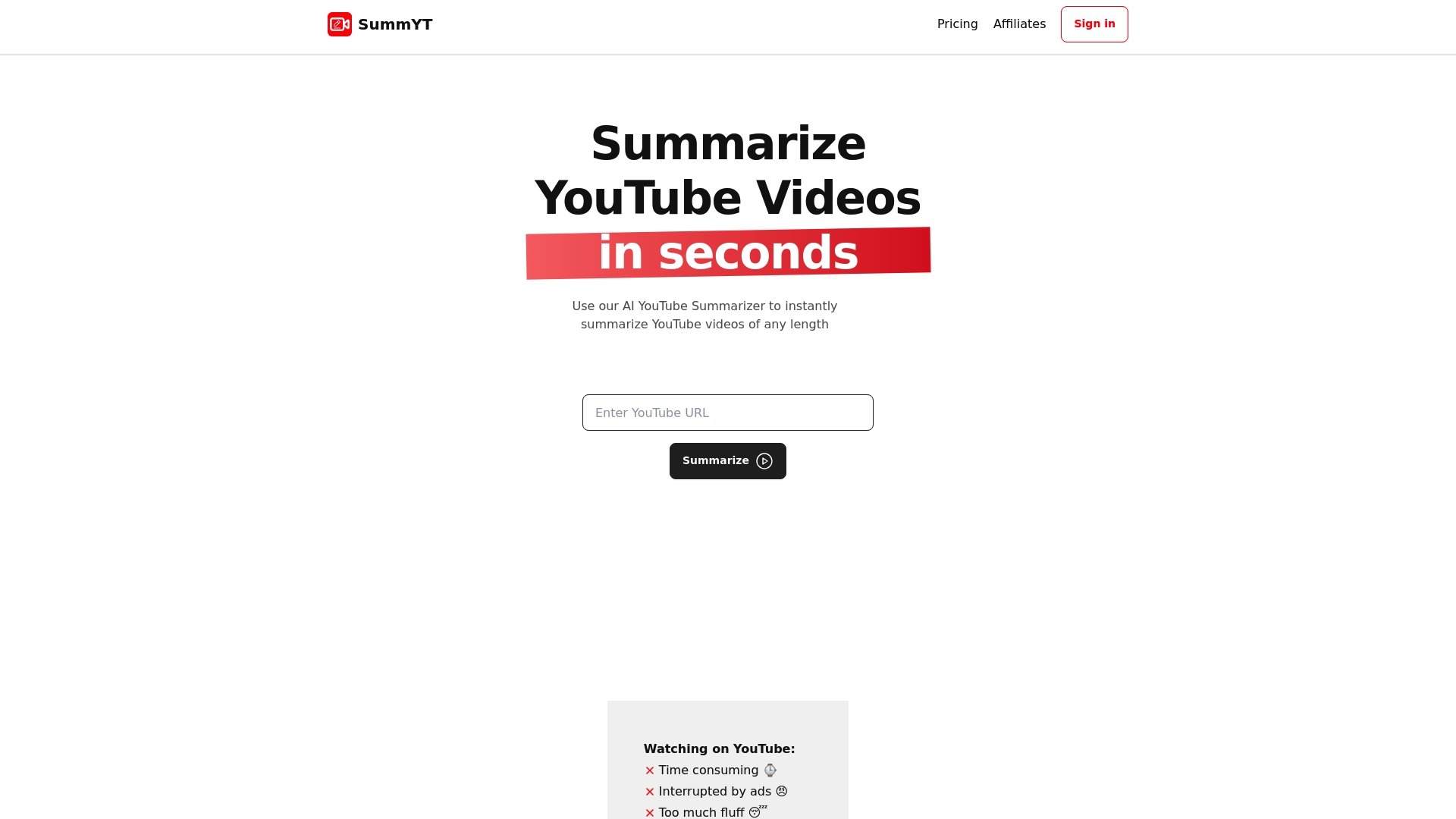Understanding the Role of Summaries in Research

Summaries are everywhere, from research papers to business reports, quietly shaping how we process information every day. Most people skim past them thinking they are just shorter versions of longer documents. But fewer realize that summaries can increase memory retention by up to 30 percent compared to reading full texts. This hidden advantage turns what looks like a shortcut into a powerful tool for learning, communication, and collaboration.
Table of Contents
- Defining Summaries And Their Purpose In Research
- The Importance Of Summaries In Processing Information
- How Summaries Enhance Understanding And Retention
- The Role Of Summaries In Communication And Collaboration
- Real-World Applications Of Summaries In Different Fields
Quick Summary
| Takeaway | Explanation |
|---|---|
| Summaries enhance comprehension and retention. | They transform complex information into concise formats, enabling faster understanding and better memory retention. |
| Effective summaries require key structural elements. | Include a concise title, background, objectives, methodology, and findings to ensure clarity and completeness. |
| Summaries facilitate knowledge transfer across disciplines. | They allow individuals from various fields to quickly grasp and engage with specialized research without extensive background knowledge. |
| Summaries improve collaboration and reduce misunderstandings. | Clear representations of discussions streamline communication, minimizing confusion and enabling faster decision-making within teams. |
| Summaries are powerful tools in scientific communication. | They bridge communication gaps by making intricate research accessible to both experts and general audiences. |
Defining Summaries and Their Purpose in Research
Research summaries serve as critical communication tools that distill complex information into concise, accessible formats. These condensed representations capture the essential elements of a research document, enabling researchers, students, and professionals to quickly understand key findings, methodologies, and conclusions without reading entire original texts.
Core Functions of Research Summaries
Research summaries perform multiple pivotal functions in academic and professional environments. Researchers use summaries to efficiently communicate their work’s core insights, facilitating knowledge transfer across disciplines and audiences. The primary objectives of research summaries include:

- Providing rapid comprehension of complex research
- Enabling quick evaluation of scholarly work
- Supporting evidence-based decision making
- Facilitating interdisciplinary understanding
Structural Elements of Effective Summaries
An effective research summary requires careful construction that maintains the original research’s integrity while presenting information succinctly. Key structural components typically include:
- Concise title reflecting research focus
- Brief background or context
- Primary research objectives
- Methodology overview
- Principal findings and conclusions
These elements work together to create a comprehensive yet compact representation of scholarly work.
Below is a table outlining the essential structural elements found in effective research summaries and the function each component serves.
| Structural Element | Purpose/Function |
|---|---|
| Concise title | Clearly communicates the research focus |
| Brief background/context | Provides essential context and relevance |
| Primary research objectives | States the main goals of the research |
| Methodology overview | Summarizes approaches or techniques used |
| Principal findings | Highlights key results and data |
| Conclusions | Presents major insights and implications |
Academic research summaries differ from general summaries by maintaining strict adherence to scientific communication standards, ensuring precision and objectivity.
By transforming lengthy research documents into digestible formats, summaries democratize knowledge access, allowing individuals with varying levels of expertise to engage with complex scholarly work. Check out our guide on different types of content summaries to understand more about how summaries can enhance information comprehension across various domains.
The Importance of Summaries in Processing Information
Summaries play a crucial role in transforming how individuals consume and comprehend complex information across various domains. By condensing extensive content into focused representations, summaries enable faster cognitive processing and more efficient knowledge acquisition.
Cognitive Processing and Information Retention
Research demonstrates that summaries fundamentally enhance human information processing capabilities. Our cognitive systems struggle with overwhelming amounts of data, and summaries act as cognitive filters that streamline complex information into manageable cognitive chunks. This process supports:
- Rapid comprehension of complex ideas
- Enhanced memory retention
- Reduced cognitive load
- Improved decision making
Strategic Information Management
In professional and academic environments, summaries serve as strategic tools for information management. Effective summaries transform large volumes of data into actionable insights, allowing professionals to quickly assess and utilize critical information. Strategic benefits include:
- Accelerated research and learning processes
- Efficient knowledge transfer
- Simplified interdisciplinary communication
- Improved workflow productivity
By distilling complex narratives into concise representations, summaries bridge knowledge gaps and democratize information access.
The following table compares the cognitive and professional benefits of using summaries, highlighting their impact on information processing and workplace efficiency.
| Area of Benefit | Key Impact of Summaries |
|---|---|
| Cognitive Processing | Speeds up comprehension of complex ideas |
| Memory Retention | Boosts retention by reducing cognitive overload |
| Decision Making | Supports quicker, more informed decisions |
| Knowledge Transfer | Allows efficient sharing across disciplines |
| Workflow Productivity | Improves task efficiency and knowledge use |
Learn more about our approach to summarizing video content and how technology can further enhance information processing strategies.
Ultimately, summaries are not mere abridged versions of content but powerful cognitive tools that enable more intelligent, efficient information engagement across personal and professional domains.
How Summaries Enhance Understanding and Retention
Summaries represent a powerful cognitive tool that dramatically transforms how individuals process, comprehend, and remember complex information. By strategically distilling extensive content into focused, digestible formats, summaries enable more effective learning and knowledge retention across various academic and professional domains.
Neurological Mechanisms of Comprehension
Cognitive science research reveals that summaries interact directly with human neural processing mechanisms. When information is condensed, the brain can more efficiently encode and store critical details, reducing cognitive overload and improving comprehension. Key neurological benefits include:
- Minimizing working memory strain
- Facilitating faster pattern recognition
- Supporting more efficient information encoding
- Enhancing long-term memory consolidation
Psychological Foundations of Knowledge Retention
Psychological studies demonstrate that summaries leverage fundamental learning principles. By presenting information in concentrated, meaningful clusters, summaries help learners create stronger mental connections and integrate new knowledge more effectively. This process supports:
- Accelerated understanding of complex concepts
- Improved information synthesis
- Enhanced critical thinking skills
- More effective knowledge transfer
Summaries do more than simply reduce text length. They act as cognitive bridges, helping individuals navigate complex intellectual landscapes with greater ease and precision. Explore our insights on video summary benefits to understand how modern technology can further optimize learning and comprehension strategies.
Ultimately, summaries represent an essential intellectual tool that transforms passive information consumption into active, strategic knowledge acquisition.
The Role of Summaries in Communication and Collaboration
Summaries function as critical communication bridges, enabling teams and individuals to exchange complex information efficiently and effectively. By transforming lengthy discussions and extensive documents into concise, digestible formats, summaries facilitate clearer understanding and more productive collaborative interactions.
Facilitating Collaborative Knowledge Exchange
Advanced research demonstrates that summaries play a pivotal role in enhancing communication across diverse professional and academic environments. Effective summaries create shared understanding by distilling multi-layered conversations and complex documents into clear, actionable insights. Key collaborative benefits include:
- Accelerating team communication processes
- Reducing misunderstandings and information gaps
- Enabling faster decision making
- Supporting cross-functional knowledge transfer
Strategic Communication Optimization
In professional settings, summaries serve as strategic communication tools that streamline information sharing and collaboration. They transform complex narratives into structured, comprehensible formats that allow teams to quickly grasp essential information without getting lost in excessive details. Important communication advantages encompass:
- Improving meeting efficiency
- Creating clear documentation of discussions
- Supporting remote and asynchronous collaboration
- Enhancing organizational knowledge management
Learn more about summarization techniques for professional communication to understand how advanced technologies are revolutionizing information exchange. By bridging communication gaps and promoting clarity, summaries emerge as indispensable tools in modern collaborative environments.
Real-World Applications of Summaries in Different Fields
Summaries transcend theoretical concepts, becoming powerful practical tools across diverse professional domains. By transforming complex information into accessible formats, summaries enable more efficient knowledge transfer and decision-making processes in multiple sectors.
Scientific and Medical Research Applications
Scientific research demonstrates that summaries play a critical role in translating complex academic findings into actionable insights. Plain-language summaries help researchers communicate intricate discoveries more effectively, bridging communication gaps between specialized experts and broader audiences. Key scientific applications include:
- Simplifying complex research findings
- Facilitating interdisciplinary understanding
- Supporting rapid knowledge dissemination
- Enabling faster scientific collaboration
Professional and Organizational Contexts
In professional environments, summaries serve as strategic communication instruments that streamline information processing across multiple sectors. They transform extensive documents, reports, and discussions into concise, comprehensible formats that support efficient organizational decision-making. Critical professional benefits encompass:
- Accelerating project management workflows
- Enhancing executive briefing processes
- Supporting quick strategic assessments
- Improving cross-departmental communication
Explore advanced content summarization techniques to understand how technology is revolutionizing information processing. By converting complex narratives into digestible insights, summaries continue to reshape how professionals across industries capture, understand, and act on critical information.

Start Turning Research Video Content Into Instant Knowledge
Struggling to process complex research, lengthy lectures, or detailed professional webinars in less time? This article explains how summaries empower quicker understanding and better memory of key concepts, highlighting the real pain point faced by students, researchers, professionals, and lifelong learners: information overload. The ability to distill large amounts of video knowledge into concise, actionable insights is essential for staying productive and informed without burning hours.

Why settle for time-consuming note-taking or risk missing critical information? Experience the benefits of AI-powered video summaries that capture every important point from educational videos, lectures, and interviews. With SummYT, you can generate unlimited, clear summaries of YouTube content, making research and learning dramatically faster. Ready to streamline your workflow and boost your retention? Visit SummYT’s main site now and see how effortless smart video summarization can be. Do not wait. Transform your research process and never feel overwhelmed by video-based information again. Explore the platform or learn more about summarizing video content to start saving hours today.
Frequently Asked Questions
What is the purpose of research summaries?
Research summaries distill complex information into concise formats, capturing essential elements of a research document to facilitate rapid comprehension and knowledge transfer.
How do summaries enhance cognitive processing and information retention?
Summaries streamline complex information into manageable chunks, minimizing cognitive load and improving memory retention, helping individuals process and understand ideas more effectively.
What are the key structural components of an effective research summary?
An effective research summary typically includes a concise title, background context, key research objectives, methodology overview, and principal findings and conclusions.
In what ways do summaries aid communication and collaboration in professional environments?
Summaries facilitate clearer understanding and more productive interactions by transforming lengthy discussions and documents into concise formats, accelerating communication, and reducing misunderstandings.



